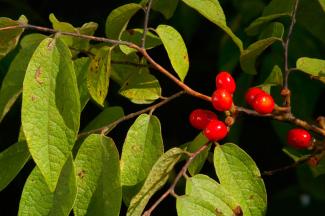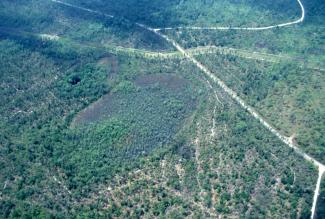Water, Air and Soil
Found throughout the forest are two special geological features: Carolina bays and limestone sinks. Limestone sinks are home for many rare plants such as the endangered Pondberry(Lindera melissifolia).

Carolina Bays have been a source of fascination for visitors to South Carolina’s lowcountry since the time of their discovery. They are fragile and unique ecosystems, wetland habitats that exhibit a variety of vegetative components.
Only about 200 of South Carolina’s original 2,600 natural bays have remained in their pristine state. Many have fallen victim to drainage and clearing. There are about 25 well-defined Carolina Bays on the forest.
All of the bays on the forest are protected, as are the forest’s four federally-designated wilderness areas.
Prehistoric Indians occupied the area long before General Francis Marion and the British fought in its swamps. The 4,000-year-old Sewee Shell Mound near a salt marsh off the Sewee Trail remains as a monument to their culture. It is the northernmost of a number of coastal shell middens along the Florida, Georgia and South Carolina coasts.

Timber management began with a policy statement in 1936 to growing "high–quality pine sawtimber as a chief crop. The first timber sales began in 1937, when about one million board feet of sawtimber were cut. In 1950, the timber management plan was the first plan in the country to prescribe even-aged silviculture for a national forest.
More recently, the Francis Marion has been in the process of recreating itself. In 1989 Hurricane Hugo’s 130-mph winds leveled more than a third of the forest. In following years, the resulting resurgence of young trees and understory shrubs posed a heightened threat of catastrophic fire and presented the forest with an unprecedented problem to dispose of the dense vegetation. Forest managers met the challenge by converting the chipped forest biomass into an energy source for local power; this practice continues today.
The Francis Marion is home to a variety of wildlife, including the endangered red-cockaded woodpecker. Hugo devastated what was then the second largest population of the birds in existence, uprooting or snapping most of the trees in which they made their nest cavities.
Management efforts to restore the population included the creation of artificial nesting cavities for the woodpeckers, and, by the mid-1990s, the population had rebounded to approximately 75% of its previous level. Today, the forest has exceeded its original recovery plan for the birds with 395 active clusters. Because the effort has been so successful, the Francis Marion now functions as a donor population when birds are needed to establish populations elsewhere.


